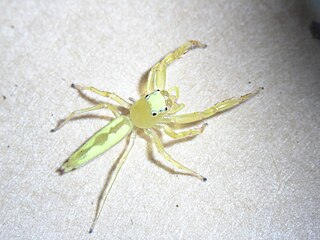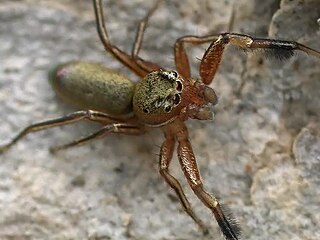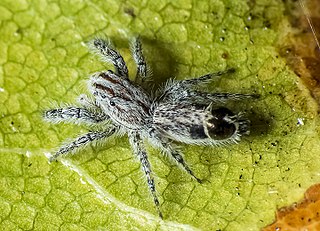
Abracadabrella is a genus of spiders in the family Salticidae whose species appear to mimic flies. The type species for the genus was described by Ludwig Koch (1879) as Marptusa elegans, transferred to Ocrisiona by Eugène Simon (1901) then placed into Abracadabrella by Marek Żabka (1991).

Afraflacilla is a genus of the spider family Salticidae. Most species are distributed in Eastern to Northern Africa and Australia, with two species found in Europe. This genus was for a time included in the genus Pseudicius, and the boundaries between both genera are disputed. In 2016 Jerzy Prószyński erected the genus Psenuc for some borderline species. The name Afraflacilla is combined from Africa, where most earlier described species were found, and FlacillaSimon, 1901, an obsolete salticid genus now called FlacillulaStrand, 1932. This genus name is in turn derived from Aelia Flaccilla, wife of Roman Emperor Theodosius I. Afraflacilla, Pseudicius, Festucula and Marchena are close relatives and form a monophyletic group.
Neaetha is a genus of jumping spiders that was first described by Eugène Louis Simon in 1885.

Pseudicius is a genus of the jumping spiders first described by Eugène Simon in 1885. The name is combined of Greek pseudo "false" and the salticid genus name Icius. The small genus Wesolowskana should possibly be included in this genus. There is some dispute whether Afraflacilla is a distinct genus or should be included in Pseudicius. Festucula and Marchena are other close relatives, these genera form a monophyletic group.
Rogmocrypta is a spider genus of the jumping spider family, Salticidae.

Stagetillus is a monotypic genus of Southeast Asian jumping spiders containing the single species, Stagetillus opaciceps. It was first described by Eugène Louis Simon in 1885, and is found only in Indonesia and Malaysia.

Trite is a genus of jumping spiders first described by Eugène Simon in 1885. Most of the 18 described species occur in Australia and New Zealand, with several spread over islands of Oceania, one species even reaching Rapa in French Polynesia.

Tutelina is a genus of jumping spiders that was first described by Eugène Louis Simon in 1901.

Viciria is a genus of jumping spiders that was first described by Tamerlan Thorell in 1877.

Zygoballus is a genus of jumping spiders found in North and South America.

Abracadabrella elegans is a species of jumping spider in the genus Abracadabrella. Its common name is Elegant Fly Mimic. It is common in coastal Eastern Australia, mostly Queensland. It appears to mimic a large fly with two black raised, rounded mounds on the rear of the abdomen, which look like eyes, and its spinnerets which resemble a fly's mouthparts. It walks backwards apparently to enhance the mimicry. Abracadabrella spp. are found on or under bark or on foliage from coastal north Queensland south to at least the central coast NSW.
Harmochirus luculentus is a species of spiders in the family Salticidae. It is found in Africa, Zanzibar and Yemen.
Hentzia elegans is a species of jumping spider found in North America. The male holotype is housed at the University of Cambridge.
Homoeomma elegans is a species of spiders in the family Theraphosidae. It is found in Argentina.

Mexcala elegans is a species of spiders in the jumping spider family, Salticidae. It is found in Southern Africa. It preys on ants.
Orchestina elegans is a species of spiders in the family Oonopidae. It is found in the Philippines.
Phiale elegans is a species of spiders of the jumping spider family, Salticidae.
Platnickia elegans is a species of spiders in the family Zodariidae. It is found in Chile and Argentina.
Schaenicoscelis elegans is a species of spiders in the family Oxyopidae. It was first described in 1898 by Simon. It is found in Brazil.
Padillothorus is a genus of jumping spiders in the family Salticidae containing the single species, Padillothorus elegans. It was first described by Jerzy Prószyński in 2018, and has only been found in Indonesia.










